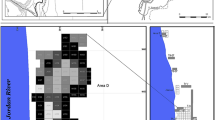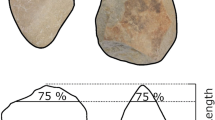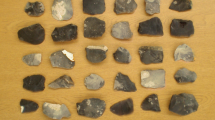Abstract
When studying bone retouchers, researchers pay close attention to the morphological characteristics of the tool’s active zone, and the lithic raw material processed. In our research, we found that the orientation of the bone retoucher in the hand and the grip employed to retain and manipulate it are crucial factors that affect the morphological characteristics of the retoucher’s active zone. By examining two alternative grips for manipulating bone retouchers ((1) Using all the fingers of one hand in a power grip; (2) Using only the first three digits of one hand in a pinch grip), we found that when the retoucher is held in the first manner, the active area is larger, as is the amount of bone removed by the retoucher. When the retoucher was pinched with only three fingers in a precision grip, retouch damage was more densely concentrated and less bone was removed. The orientation of the retoucher in the hand and the grip employed have a greater influence on the active area than the extent of retoucher use, which we assessed by measuring the number of stone tool edges processed. By gripping the retoucher with all the fingers of one hand, the knapper automatically applies greater force, which results in the removal of more bone. Comparison of experimental bone retouchers with those recovered from Middle Paleolithic archaeological contexts in Chagyrskaya Cave (Altai, Russia) revealed that Altai Neanderthals practiced two methods of grasping bone retouchers, with a three-finger pinch grip being dominant.









Similar content being viewed by others
Notes
Following Turner et al. (2020), “bone tools” refers to retouchers and other artifacts made of vertebrate hard tissues such as bone, as well as teeth, antler and ivory.
References
Armand D, Delagnes A (1998) Les retouchoirs en os d’Artenac (couche 6c): perspectives archéozoologiques, taphonomiques et expérimentales. In: Jean-Philip, B.., Liliane, M., Patou-Mathis, M. (Eds.), Les Comportements de Subsistance Au Paléo-Lithique, XviieRencontres Internationales d’Archéologie et d’Histoired’Antibes. Sophia Antipolis, pp. 205–214
Bardo A, Moncel MH, Dunmore CJ, Kivell TL, Pouydebat E, Cornette R (2020) The implications of thumb movements for Neanderthal and modern human manipulation. Sci Rep 10:1–12. https://doi.org/10.1038/s41598-020-75694-2
Baumann M, Plisson H, Rendu W, Maury S, Kolobova K, Krivoshapkin A (2020) The Neandertal bone industry at Chagyrskaya cave, Altai Region, Russia. Quatern Int 559:68–88. https://doi.org/10.1016/j.quaint.2020.06.019
Costamagno S, Bourguignon L, Soulier M-C, Meignen L, Beauva C, Rendu W, Mussini C, Mann A, Maureille B (2018) Bone retouchers and site function in the Quina Mousterian: The case of Les Pradelles (Marillac-Le-France, France). In: Hutson, J.., García-Moreno, A., Noack, E.S., Turner, E., Villaluenga, A., Gaudzinski-Windheuser, S. (Eds.), Origins of Bone Tool Technologies. Mainz, pp. 165–196
Doyon L, Li Z, Li H, d’Errico F (2018) Discovery of circa 115,000-year-old bone retouchers at Lingjing, Henan, China. PLoS ONE 13:1–16. https://doi.org/10.1371/journal.pone.0194318
Hammer Ø, Harper DAT, Ryan PD (2001) Past: paleontological statistics software package for education and data analysis. Palaeontol Electron 4:1–9
Karr LP, Outram AK (2012) Tracking changes in bone fracture morphology over time: environment, taphonomy, and the archaeological record. J Archaeol Sci 39:555–559. https://doi.org/10.1016/j.jas.2011.10.016
Kolobova K, Chabai V, Krajcarz M, Krajcarz M, Shalagina A, Rendu W, Vasiliev SV, Markin SV, Krivoshapkin AI (2019a) Exploitation of the natural environment by Neanderthals from Chagyrskaya Cave ( Altai ). Quartar 66:7–31. https://doi.org/10.7485/QU66
Kolobova K, Shalagina A, Chabai V, Markin S, Krivoshapkin A (2019b) Signification des technologies bifaciales au Paléolithique moyen des montagnes de l’Altaï. L’anthropologie 123. https://doi.org/10.1016/j.anthro.2019.06.004
Kolobova K, Fedorchenko A, Basova N, Postnov AV, Kovalev V, Chistyakov P, Molodin V (2019c) The Use of 3D-Modeling for Reconstructing the Appearance and Function of Non-Utilitarian Items (the Case of Anthropomorphic Figurines from Tourist-2). Archaeol Ethnol Anthropol Eurasia 47:66–76. https://doi.org/10.17746/1563-0110.2019.47.4.066-076
Kolobova K, Rendu W, Shalagina A, Chistyakov P, Kovalev V, Baumann M, Koliasnikova A, Krivoshapkin A (2020a) The application of geometric-morphometric shape analysis to Middle Paleolithic bone retouchers from the Altai Mountains, Russia. Quatern Int 559:89–96. https://doi.org/10.1016/j.quaint.2020.06.018
Kolobova KA, Roberts RG, Chabai VP, Jacobs Z, Krajcarz MT, Shalagina AV, Krivoshapkin AI, Li B, Uthmeier T, Markin SV, Morley MW, O’Gorman K, Rudaya NA, Talamo S, Viola B, Derevianko AP (2020b) Archaeological evidence for two separate dispersals of Neanderthals into southern Siberia. Proc Natl Acad Sci USA 117:2879–2885. https://doi.org/10.1073/pnas.1918047117
Kolobova KA, Kolyasnikova AS, Chabai VP, Chistyakov PV, Baumann M, Markin SV, Krivoshapkin AI (2020c) Middle paleolithic bone retouchers: Size or proportions. Archaeol Ethnol Anthropol Eurasia 48:14–26. https://doi.org/10.17746/1563-0110.2020.48.4.014-026
Mallye JB, Thiébaut C, Mourre V, Costamagno S, Claud É, Weisbecker P (2012) The Mousterian bone retouchers of Noisetier Cave: Experimentation and identification of marks. J Archaeol Sci 39:1131–1142. https://doi.org/10.1016/j.jas.2011.12.018
Mateo-Lomba P, Fernández-Marchena JL, Ollé A, Cáceres I (2020) Knapped bones used as tools: experimental approach on different activities. Quatern Int 569–570:51–65. https://doi.org/10.1016/j.quaint.2020.04.033
Mozota M (2013) An experimental programme for the collection and use of retouching tools made on diaphyseal bone splinters. EXARC J 2
Mozota M (2018) Experimental programmes with retouchers: where do we stand and where do we go now? In: Hutson, J.., García-Moreno, A., Noack, E.S., Turner, E., Villaluenga, A., Gaudzinski-Windheuser, S. (Eds.), The Origins of Bone Tool Technologies. Mainz, pp. 15–32
Niewoehner WA, Bergstrom A, Eichele D, Zuroff M, Clark JT (2003) Manual dexterity in Neanderthals. Nature 422:395. https://doi.org/10.1038/422395a
Rigaud A (1977) Analyse typologique et technologique des grattoirs magdaléniens de La Garenne à Saint-Marcel (Indre). Gallia Préhistoire 20:1–43
Salazar-García DC, Power RC, Rudaya N, Kolobova K, Markin S, Krivoshapkin A, Henry AG, Richards MP, Viola B (2021) Dietary evidence from Central Asian Neanderthals : a combined isotope and plant microremains approach at Chagyrskaya Cave, Altai. J Hum Evol 156:102985. https://doi.org/10.1016/j.jhevol.2021.102985
Semenov SА (1957) Primitive Technique (Experience of the Study of Ancient Tools and Products by Traces of Work). Moscow, Leningrad, Publishing house of the USSR Academy of Sciences (In Russian)
Shalagina AV, Krivoshapkin AI, Kolobova KA (2015) Truncated-faceted pieces in the paleolithic of northern Asia. Archaeol Ethnol Anthropol Eurasia 43:33–45
Shalagina A, Kolobova K, Krivoshapkin A (2019) Scar pattern analysis as a method for the reconstruction of lithic artifacts production sequence. Stratum plus 2019:145–154
Shalagina AV, Kharevich V, Baumann M, Kolobova KA (2020) Reconstruction of the bifacial technological sequence in Chagyrskaya Cave assemblage. Siber Hist Res 3:130–151. https://doi.org/10.17223/2312461X/29/9
Soressi M, McPherron SP, Lenoir M, Dogandžić T, Goldberg P, Jacobs Z, Maigrot Y, Martisius NL, Miller CE, Rendu W, Richards M, Skinner MM, Steele TE, Talamo S, Texier JP (2013) Neandertals made the first specialized bone tools in Europe. Proc Natl Acad Sci USA 110:14186–14190. https://doi.org/10.1073/pnas.1302730110
Tartar É (2002) Étude fonctionnelle d’os à impressions de Starosele et Kabazi V (Crimée, Ukraine)
Tartar É (2009) De l’os à l’outil : caractérisation technique, éco-nomique et sociale de l’utilisation de l’os à l’Aurignacien ancien.Étude de trois sites : l’Abri Castanet (secteurs nord et sud), Brassempouy (grotte des Hyènes et abri Dubalen) et Gatzarria. Thèse de doctorat, université Paris I, Panthéon-Sorbonne
Vernot B, Zavala EI, Gómez-Olivencia A, Jacobs Z, Slon V, Mafessoni F, Romagné F, Pearson A, Petr M, Sala N, Pablos A, Aranburu A, de Castro JMB, Carbonell E, Li B, Krajcarz MT, Krivoshapkin AI, Kolobova KA, Kozlikin MB, Shunkov MV, Derevianko AP, Viola B, Grote S, Essel E, Herráez DL, Nagel S, Nickel B, Richter J, Schmidt A, Peter B, Kelso J, Roberts RG, Arsuaga J-L, Meyer M (2021) Unearthing Neanderthal population history using nuclear and mitochondrial DNA from cave sediments. Science 372:eabf1667. https://doi.org/10.1126/science.abf1667
Veselsky AP (2008) Kabazi V: Bone and Stone Tools Used in Flint Knapping. Kabazi V: Interstratification of Micoquian & Levallois-Mousterian camp sites 427–453
Vettese D, Blasco R, Cáceres I, Gaudzinski-Windheuser S, Moncel MH, Hohenstein UT, Daujeard C (2020) Towards an understanding of hominin marrow extraction strategies: a proposal for a percussion mark terminology. Archaeol Anthropol Sci 12. https://doi.org/10.1007/s12520-019-00972-8
Villa P, Mahieu E (1991) Breakage patterns of human long bones. J Hum Evol 21:27–48. https://doi.org/10.1016/0047-2484(91)90034-S
Vincent A (1993) L’outillage osseux au Paleolithique moyen: une nouvelle approche. PhD thesis, University Paris X-Nanterre
Acknowledgements
This study was generously supported by a Russian Science Foundation grant (# 21-18-00376). Olsen’s participation was facilitated by the University of Arizona’s Je Tsongkhapa Endowment for Central and Inner Asian Archaeology. Baumann’s participation was supported by a Marie Sklodowska-Curie Actions postdoctoral fellowship (#839528). The authors are grateful to the anonymous reviewers of our draft manuscript for their helpful comments and suggestions.
The authors have no competing interests to declare. This study did not involve any underlying data.
Author information
Authors and Affiliations
Corresponding author
Additional information
Publisher's Note
Springer Nature remains neutral with regard to jurisdictional claims in published maps and institutional affiliations.
Supplementary Information
Below is the link to the electronic supplementary material.
Supplementary file1 (AVI 27842 KB)
Supplementary file2 (AVI 13231 KB)
Rights and permissions
About this article
Cite this article
Kolobova, K., Kharevich, V., Chistyakov, P. et al. How Neanderthals gripped retouchers: experimental reconstruction of the manipulation of bone retouchers by Neanderthal stone knappers. Archaeol Anthropol Sci 14, 26 (2022). https://doi.org/10.1007/s12520-021-01495-x
Received:
Accepted:
Published:
DOI: https://doi.org/10.1007/s12520-021-01495-x




